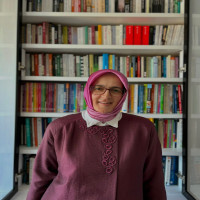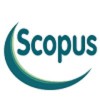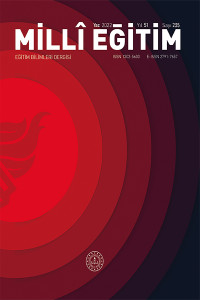Research Article
Aim & Scope
Eğitime ilişkin bilgi, uygulama, sorun ve önerilerin bilimsel, akademik ve kuramsal düzlemde ortaya konulmasını, tartışılmasını ve taraflara ulaştırılmasını sağlamaktır.
Millî Eğitim dergisinde eğitim alanındaki makalelere yer verilir. Makalelerde araştırmaya dayalı olma, alana katkı sağlama, uygulamaya ilişkin öneriler ortaya koyma, yeni ve farklı gelişmeleri irdeleme, güncel olma ölçütleri dikkate alınır. Millî Eğitim dergisinde yayımlanacak makalelerin daha önce başka yayın organında yayımlanmamış veya yayımlanmak üzere kabul edilmemiş olması gerekir. Sempozyum veya kongre gibi bilimsel toplantılarda sunulan bildirilerde bilimsel toplantının adı, yeri ve tarihi belirtilmelidir. Bir araştırma kurumu veya kuruluşu tarafından desteklenen çalışmalarda desteği sağlayan kuruluşun adı, projenin ismi, (varsa) tarih, sayı ve numarası anılmalıdır.
Millî Eğitim Dergisinde aşağıdaki konu başlıklarına uygun makalelere yer verilir.
EĞİTİM BİLİMLERİ VE ÖĞRETMEN YETİŞTİRME
1) Bilgisayar ve Öğretim Teknolojileri Eğitimi
a) Açık ve Uzaktan Öğrenme
b) Bilişim Teknolojileri Eğitimi
c) Eğitim Teknolojileri
d) Materyal Geliştirme
e) Öğretim Tasarım
f) Uzaktan Eğitim Tasarımı ve Yönetimi
2) Din Kültürü ve Ahlak Bilgisi Eğitimi
3) Eğitim Bilimleri
a) Eğitim Felsefesi
b) Eğitim Politikaları
c) Eğitim Programları ve Öğretim
d) Eğitim Psikolojisi
e) Eğitim Sosyolojisi
f) Eğitim Tarihi
g) Eğitim Yönetimi
h) Eğitimde Ölçme ve Değerlendirme
i) Eğitimin Sosyal ve Tarihi Temelleri
j) Eğitim/Öğretim Teknolojileri
k) Hayat Boyu Öğrenme
l) Yetişkin Eğitimi
4) Güzel Sanatlar Eğitimi
a) Müzik Eğitimi
b) Resim/Resim-İş Eğitimi
5) Matematik ve Fen Bilimleri Eğitimi
a) Biyoloji Eğitimi
b) Fizik Eğitimi
c) Kimya Eğitimi
d) Matematik Eğitimi
6) Özel Eğitim
a) Çok Engellilerin Eğitimi
b) Görme Engeliler Eğitimi
c) Konuşma Engelliler Eğitimi
d) Özel Yetenekliler Eğitimi
e) Zihin Engelliler Eğitimi
7) Rehberlik ve Psikolojik Danışmanlık
a) Aile Danışmanlığı
b) Kariyer Danışmanlığı
c) Madde Bağımlılığı Danışmanlığı
d) Okul Psikolojik Danışmanlığı
e) Psikolojik Danışmanlık Eğitimi
8) Sosyal Bilimler Eğitimi
a) Coğrafya Eğitimi
b) Tarih Eğitimi
9) Temel Eğitim
a) Beden Eğitimi ve Oyun
b) Biyoloji Eğitimi
c) Fen Bilgisi Eğitimi
d) Hayat Bilgisi Eğitimi
e) İlk Okuma Yazma ve Türkçe Eğitimi
f) Matematik Eğitimi
g) Okul Öncesi Eğitimi
h) Sosyal Bilgiler Eğitimi
10) Türkçe Eğitimi
11) Yabancı Dil Eğitimi
Author Guidelines
The Journal of National Education, a refereed scientific journal, is published quarterly by The Ministry of National Education. The Journal is published quarterly in February, May, August and November as winter, spring, summer and fall issues.
1. OBJECTIVE
The aim is to provide the information, practices, problems and suggestions regarding education and training are presented, discussed and delivered to the related parties, theoretically or practically, on a scientific level.
2. SUBJECT AND CONTENT
The journal of National Education includes articles in the field of education. In the articles, the criteria of being research-based, contributing to the field, making suggestions for implementation, examining new and different developments, and being up-to-date are taken into consideration.
Manuscripts must not have been previously published or accepted for publication in other media.
3. PUBLISHING AND REVIEW PROCESS
Articles are reviewed by the Editorial Board and the Pre-Review Board of the journal. The submitted articles are first evaluated by the Pre-Review Board. At this stage, the articles are handled from five angles;
3.1. Compliance with Application Requirements
It is checked whether the information and documents specified in Article 6 have been uploaded completely.
3.2. Compliance with the Writing Rules of the Journal
Correct use of language and fluency, spelling rules, article word count, number of words in Turkish and English abstracts, number of keywords and compatibility of foreign language equivalents, rules of bibliography etc. are controlled.
3.3. Compliance with the Article Template
While the articles are being prepared, the article template on our DergiPark page should be used. In the evaluation process, it is checked whether the article is suitable for the template features.
3.4. Compliance with the Scope of the Journal and Scientific Requirements
Whether it has basic scientific article features such as its purpose, method and result, quality and quantity of the sample of the research, whether the research subject is up-to-date, and suggestions contribute to education, etc. matters are examined.
3.5. Legal and Ethical Compliance
The article may contain ideas, criticisms and suggestions. However, these ideas and criticisms should not constitute a legal crime, violate ethical rules, and damage the dignity of individuals and institutions.
Articles that are found not to meet any of these conditions or whose application documents are missing are directly rejected with the decision of the Pre-Review Board. In addition, articles that are out of the field, namely the articles which are incompatible with the journal’s name, subject area, memory and readership, are returned even if they are complete and very successful. Reasons for refusal are not created with long explanations one by one for such articles that are too numerous. International scientific journals have no feedback obligation.
For the manuscripts that have detected minor deficiencies that do not require a return, a resubmission is requested through the DergiPark system. Follow-up of the process is the author's responsibility. Correspondence with the authors and referees related to the Journal of National Education is carried out through the DergiPark system and there is no opportunity or obligation to communicate with each author through different channels within the current workload.
The reviewed articles are submitted to the Editorial Board for scientific evaluation when necessary. These articles appropriate for publication principles are also checked for plagiarism. For this purpose, the article owners have to send the similarity report created using one of the internationally accepted similarity screening programs (eg iThenticate) in the attachment of the article. All responsibility for similarity belongs to the author. The similarity rate accepted by the National Education Journal is kept confidential in order to carry out the process in a healthy way. This rate has been determined by the Editorial Board by the evaluation and confirmation of the rate proposed by ULAKBİM and the relevant authorities.
An Ethics Committee Permit must be submitted for all articles. In cases where an Ethics Committee Permission Document is not required, authors must upload a document explaining the reason for this to the system. The institution, date and number of decisions from which the Ethics Committee was obtained should be specified in the method section of the article. If there is no need for Ethics Committee Permission, the justification should be explained in the method section. Institutional or individual application permissions obtained for the research do not replace Ethics Committee Permission.
Articles approved by the Pre-Review or Editorial Board are sent to two qualified referees who are well known in the field with their works. In the event of an acceptance and a rejection in the decisions, the third referee opinion is taken. The refereeing process is carried out until two positive or two negative reports received about the article. Invitations are sent to a maximum of twelve referees for an article. If there is no result from the referees in this process, the article is returned. Referee reports are confidential and kept for five years. The pre-review process takes an average of one month, and the referee process takes an average of six months. In some cases, this period may be longer. Detailed information about the referee process is explained in detail in the “Blind Referee System” section of the DergiPark Page.
Authors should take into consideration the criticism, corrections and suggestions by the referees and the Editorial Board. If there is a disagreement by the author, he/she has a right to explain it with justifications. The corrections made must be uploaded to the system during the revision process using the Referee Correction Chart on our DergiPark page. The Editorial Board or editorial unit has the right to make minor corrections, which do not change the whole meaning. The responsibility of the findings and opinions in the published articles belongs to their authors.
Printed issue is published on the Internet at http://dhgm.meb.gov.tr and ULAKBIM ODIS and DergiPark.
Text and photos can be quoted by showing the source.
4. LANGUAGE of WRITING
Articles must be submitted in Turkish. However, papers in English can be published if they do not exceed one-third of the whole articles of the journal. Both Turkish and English abstracts of the article are required. Abstract and keywords -both Turkish and English- must comply with international standards (for example; keywords list in TR Index, CAB Theasarus, JISCT, ERIC etc. sources can be used)
The writing guidelines by the Turkish Language Institution must be followed in articles.
5. WRITING RULES AND STRUCTURE OF ARTICLE
Submitted articles must comply with national and international ethical rules and research and publication ethics.
The following rules using our journal's article template must be taken into consideration:
5.1. Title
Articles must have a title. It should indicate the subject in the best way in Turkish and English, should not exceed fifteen words, should be written in bold with the first letters capitalized.
5.2. Article type
It should be written in bold, all capital letters under the title.
5.3. Author name(s) and addresses
Author names, titles, institutions, addresses, e-mail addresses and ORCID information should be specified.
Formatting in the template should be considered.
5.4. Abstract
Turkish and English abstract (adding keywords) should be made. Abstracts should not exceed two hundred and fifty words, and should reflect the entire article in the shortest and most concise manner (especially the purpose of the study, research method and result). It should be one paragraph and justified. It should be written with Times New Roman, 10 font, italic, bold, single line spacing. Keywords that reflect the integrity of the work should be given by leaving one blank line under the abstract. All of these keywords should be written in lowercase (except for proper names and capitalized abbreviations), and concepts should be listed from general to specific. The number of keywords should be between 3 and 8, no full stop should be used at the end. English abstract and keywords should have the same characteristics.
5.5. Article
Article should start with an introductory part that specifies the purpose, scope and methods of the study. It should continue with intermediate and sub-sections such as data, observations, opinions, comments, discussions and it should end with discussion, conclusion and suggestion sections.
5.5.1. Main Text: The article should be written on A4 size page, with 1.5 line spacing and 11 font size in Times New Roman, with 1.25 paragraph indentation and 6 nk paragraph spacing. 3 cm space should be left at the edges of the pages and the pages should be numbered. The articles should not exceed eight thousand words and thirty pages. Additions to be made in line with referee requests are not included in this limitation.
5.5.2. Main titles: These are consist of abstract, sections of the main text (introduction, method, findings, discussion, conclusion, suggestions), acknowledgments (if any), bibliography and (if any) annexes. Main titles should be written in capital letters only the first letter of each word, the others in lowercase, Times New Roman, 12 pt, centered and bold.
5.5.3. Minor titles: It should be written in bold, left-justified, Times New Roman, 11 font size. Only the first letter of each word should be capitalized and a carriage return should be placed at the end of the title.
5.5.4. Subtitles: All should be written in bold, left-justified, Times New Roman, 11 font size and only the first letter in the first word of the title must be capital. The text should be continued on the same line with a colon at the end of the title.
5.5.5. Figures: Figures should be drawn with a resolution that will not cause any problem in reduction and printing, and by choosing a smooth and sufficient line thickness. Each figure should be on a separate page. They should be numbered starting from "1", each figure should be numbered separately and a title should be written on each figure.
5.5.6. Tables: Like figures, they should be numbered separately starting from "1" and the numbers should be written on each table with its title.
Titles of figures and tables should be concise and the first letter of each word should be capitalized and the other letters should be written in lowercase. When necessary, explanatory footnotes or abbreviations should be given just below the figures and tables.
5.5.7. Images: It should be high resolution (300 dpi), bright and clear. In addition, the same rules for figures are applied.
Figures, tables and images should not exceed ten pages. Must be sent embedded in the text. If these images are thought to not be clear in printing, the original one is asked from the author.
5.5.8. Citing References In The Text: While giving references in the text, the following rules should be followed and the examples given should be taken as basis. The source should not be given in the form of a footnote.
a. For single author, last name should be followed by publication date in parenthesis:
(Güneş, 2006) or Güneş (2006) or according to the study of Güneş (2006) ...
b. When citing references with two authors in the text, "and" should be used between the surnames of the researchers as in the example below, and the publication date of the work should be given:
(Can and Gündüz, 2019) or Can and Gündüz (2019)
(Miles and Huberman, 1998) or Miles and Huberman (1998)
For multiple references, semi-column (;) should be used between the references and they should be written alphabetically as follows:
(Aydoğdu, 2020; Köksal, 2007; Öğülmüş, 1993; Safran and Aktaş, 2012)
c. While the publications with three or more authors are mentioned in the text, all the author's surnames are included for the first time, in the following citations, the name of the first author should be specified as follows, for the others “et al.” statement should be used. However, the names of all authors should be included in the resource directory:
Çepni, Ayvacı and Bakırcı (2015) or (Çepni, Ayvacı & Bakırcı, 2015) (first citation)
Çepni et al. (2015) or (Çepni et al., 2015) (second and subsequent references)
Dowden, Pittaway, Yost, & McCarthy, (2013) or (Dowden, Pittaway, Yost, & McCarthy, 2013) (first citation)
Dowden et al. (2013) or (Dowden et al., 2013) (second and subsequent references)
ç. When citing an unreachable publication in the text, the source from which the citation was made should be specified as follows. Only "citing" information should be included in the bibliography:
Köprülü (1911) (cited in Çelik, 1998) or (as cited in Köprülü, 1998) or Köprülü's (1911) (as cited in Çelik, 1998)…
d. Personal interviews should be mentioned in the text by indicating the surname and date of the interview. In addition, these interviews should be specified in the bibliography.
(Tarakçı, 2004)
e. Studies of institutions and organizations should be stated as follows.
Ministry of National Education (2018) or (Ministry of National Education, 2018) first reference
MEB (2018) or (MEB, 2018) later citations
5.6. Contributions
If there are contributors other than the author, these names should also be stated at the end of the article.
In studies supported by a research institution or organization, the name of the organization providing support, the name of the project, date (if any), number and number should be given.
5.7. References
References list should be added at the end of the article. The bibliography should be in accordance with APA 7, one of the international reference writing styles. It should be prepared in alphabetical order based on the surnames of the authors according to the following rules. The use of uppercase / lowercase letters should be arranged as follows in order to ensure spelling uniformity in the journal.
5.7.1. Periodicals
Author names, date, title of the article (italic), name of the periodical (not abbreviated), volume number (italic), (issue number), page number information should be included. If there is a DOI number, it should be given starting with http:
Öntaş, T., & Kaya, B. (2019). Examining the opinions of elementary teacher candidates about giving feedback in the process of teaching material design. Milli Eğitim, 48 (224), 59-73. https://dx.doi.org/10.37669/milliegitim.648686
Maier, U., Wolf, N., ve Randler, C. (2016). Effects of a computer-assisted formative assessment intervention based on multiple-tier diagnostic items and different feedback types. Computers & Education, 95, 85-98. https://doi.org/10.1016/j.compedu.2015.12.002
If the journal does not use volume, issue and / or article or page numbers, missing items should be excluded from the reference.
Bozan, M. (2004). Bölge yönetimi ve eğitim bölgeleri kavramı. Millî Eğitim, Kış 2004, S 161, 95-111.
5.7.2. Presentations
Author names, full date, title of the paper (in italics), name of the symposium or congress, editors, printing house, volume number, page number, place name information should be included.
The presentation should be explained in square brackets after the title. The description is flexible (eg "[Conference session]," "[Paper presentation]," "[Poster session]," "[Oral presentation]", "[Conference presentation summary]").
Güneş Koç, R. S., and Sarıkaya, M. (2018, 6-8 September). Investigation of the effect of context-based teaching method supported 5E, 5E teaching method and context-based teaching method on the success of 7th grade students in science lesson and the permanence of their knowledge [Oral presentation]. I. ILTER International Learning, Teaching and Education Research Congress, Amasya University, Amasya.
Rayner, A. (2005, September). Reflections on context based science teaching: A case study of physics students for physiotherapy [Poster presentation]. Annual UniServe Science Blended Learning Symposium Proceedings, Sydney.
5.7.3. Books
Author name(s), date, Book title (first letters in capital case, in italic), publisher information should be included. City name should not be written.
Beyatlı, Y. K. (1985). Our own sky dome. Ministry of National Education Publications.
Miles, M. B., ve Huberman, A. M. (1994). Qualitative data analysis: An expanded sourcebook. Sage Publications.
Book with Editor:
Safran, M. (Edt.) (2019). Those who direct the world education (Vol 1-2). Ministry of National Education Publications.
Chapter in an Edited Book
In English-edited books, "in" should be used and the place of publication (province) should not be specified.
Nofal, N. (2019). Gazali. Safran, M. (Edt.), Dünya eğitimine yön verenler I (s 341- 363). Millî Eğitim Bakanlığı Yayınları.
Author, A. A., & Author, B. B. (Year). Title of chapter. In A. A. Editor & B. B. Editor (Eds.), Title of book (pages of chapter). Publisher.
5.7.4. Reports and Theses:
It should be given as shown in the explanation and example below.
Author name (s), date, report or thesis title [if published or unpublished and type of report or thesis]. Institution or university name, department, place.
Azer, H. (2017). Bibliography of printed works in Ottoman Turkish in the archive library of the Ministry of National Education [Unpublished master's thesis]. Kırıkkale University, Institute of Social Sciences, Kırıkkale.
5.7.5. Internet References
Author name or institution name, date of publication on the internet. Title of the publication (in italics). Internet address should be included.
Bozan, M. (2004, 1 Şubat). District management and educational districts concept. http://www.yayim.meb.gov.tr
TÜBİTAK (2020, 18 Mayıs). UBYT program and journal list. https://ulakbim.tubitak.gov.tr/tr/haber/tubitak-2020-ubyt-programi-ve-dergi-listesi-ilan-edildi
For quotations other than these, APA 7 style should be used. (You can use the address https://apastyle.apa.org/products/publication-manual-7th-edition)
6. ARTICLE SUBMISSION
Millî Eğitim Dergisi aims to publish qualified studies that can contribute to our education system, in line with science and scientific publication ethics, under the supervision of expert referees. An objective evaluation and publication process in accordance with blind referee system is considered important. For this reason, the authors must follow the whole process through the DergiPark system. Articles sent to the journal’s personal e-mails or e-mails of the journal are not considered because they are not suitable for the blind review system.
In order to submit an article, the following files and documents should be uploaded to the DergiPark system at the web site of http://www.dergipark.org.tr/milliegitim.
Required Documents
2. Full text of the article with the name of the author (in Word file format)
3. Full text of the article without the name of author (in Word file format)
4. Similarity report (full report in PDF format)
6. Ethics Committee Permission
The authors who submit the article are deemed to have accepted all the conditions stated in the publication principles of Millî Eğitim Dergisi.
Ethical Principles and Publication Policy
- Millî Eğitim dergisi, Millî Eğitim Bakanlığının bir yayını olup öğretmenlerimize, akademik camiaya ve Eğitim Bilimleri alanına katkıda bulunmayı amaçlar.
- Millî Eğitim dergisine gönderilen makaleler, Anayasa ve Kanunlara, bilimselliğe, objektifliğe ve etik ilkelere aykırı olmamalıdır.
- Bilimsel nitelikler taşımayan, kurum ve dergi saygınlığını zedeleyecek, kamuoyunda tartışma yaratacak çalışmalara yer verilmez.
- Millî Eğitim Dergisine makale göndermek ve yayın süreci ile ilgili tüm iş ve işlemler ücretsizdir. Herhangi bir ücret talep edilmez.
- Millî Eğitim Dergisinde aşağıdaki konu başlıklarına uygun makalelere yer verilir.
EĞİTİM BİLİMLERİ VE ÖĞRETMEN YETİŞTİRME
1) Bilgisayar ve Öğretim Teknolojileri Eğitimi
a) Açık ve Uzaktan Öğrenme
b) Bilişim Teknolojileri Eğitimi
c) Eğitim Teknolojileri
d) Materyal Geliştirme
e) Öğretim Tasarım
f) Uzaktan Eğitim Tasarımı ve Yönetimi
2) Din Kültürü ve Ahlak Bilgisi Eğitimi
3) Eğitim Bilimleri
a) Eğitim Felsefesi
b) Eğitim Politikaları
c) Eğitim Programları ve Öğretim
d) Eğitim Psikolojisi
e) Eğitim Sosyolojisi
f) Eğitim Tarihi
g) Eğitim Yönetimi
h) Eğitimde Ölçme ve Değerlendirme
i) Eğitimin Sosyal ve Tarihi Temelleri
j) Eğitim/Öğretim Teknolojileri
k) Hayat Boyu Öğrenme
l) Yetişkin Eğitimi
4) Güzel Sanatlar Eğitimi
a) Müzik Eğitimi
b) Resim/Resim-İş Eğitimi
5) Matematik ve Fen Bilimleri Eğitimi
a) Biyoloji Eğitimi
b) Fizik Eğitimi
c) Kimya Eğitimi
d) Matematik Eğitimi
6) Özel Eğitim
a) Çok Engellilerin Eğitimi
b) Görme Engeliler Eğitimi
c) Konuşma Engelliler Eğitimi
d) Özel Yetenekliler Eğitimi
e) Zihin Engelliler Eğitimi
7) Rehberlik ve Psikolojik Danışmanlık
a) Aile Danışmanlığı
b) Kariyer Danışmanlığı
c) Madde Bağımlılığı Danışmanlığı
d) Okul Psikolojik Danışmanlığı
e) Psikolojik Danışmanlık Eğitimi
8) Sosyal Bilimler Eğitimi
a) Coğrafya Eğitimi
b) Tarih Eğitimi
9) Temel Eğitim
a) Beden Eğitimi ve Oyun
b) Biyoloji Eğitimi
c) Fen Bilgisi Eğitimi
d) Hayat Bilgisi Eğitimi
e) İlk Okuma Yazma ve Türkçe Eğitimi
f) Matematik Eğitimi
g) Okul Öncesi Eğitimi
h) Sosyal Bilgiler Eğitimi
10) Türkçe Eğitimi
11) Yabancı Dil Eğitimi
Price Policy
Millî Eğitim Dergisinde başvuru, inceleme, değerlendirme, okuma, yayınlama vb. adı altında herhangi bir ücret talep edilmez. Dergiye makale gönderilmesi ve değerlendirme sürecinde kabul gören makalelerin yayınlanması tamamen ücretsizdir.
Indexes
Citation Indexes
Other Indexes
Journal Boards
General Publishing Director

Publishing Director

Publications Coordinator

I am a mathematics education researcher with a diverse background in teaching, academic research, and educational policy. I hold an MA in Mathematics Education from UCL Institute of Education (UK), and a PhD from the Mathematics Education Centre at Loughborough University (UK), where I focused on the intersection of mathematical cognition and education.
Over the years, I've worked as a Research Associate at Loughborough University’s Centre for Mathematical Cognition (2021-2022) and in the Department of Psychological Sciences at the University of Missouri (US) (2024-2025). My experience also includes working with the Turkish Ministry of Education as an education expert, contributing to national curriculum development and teacher training (2023-recent).
My research interests lie in mathematical cognition, primary mathematics education, and evidence-based practices that enhance teaching and learning. I am passionate about connecting research with practice to improve educational outcomes on both local and global scales.
editor-in chef
Mehmet TAŞPINAR was born in Konya. He completed his primary and secondary education in Konya and undergraduate education in Faculty of Technical Education at Gazi University. He worked as a technical teacher at Technical High Schools and Vocational High Schools in Eskişehir and Elazığ in 1984-1992. In 1992, he started to work as a research assistant in Faculty of Technical Education at Fırat University. He completed his master’s degree in the Department of Educational Sciences at the Institute of Social Sciences in 1993 and he completed his PhD in 1997. He stayed in Ohio State University in America for nine months in 1994 as a visiting scholar. He got the title of Ass. Prof in 1997 and title of Assoc. Prof in 2001. He worked in Turkish Manas University in Kyrgyzstan as a visiting scholar in 2003. He got the title of Prof. at the Department of Educational Sciences, Faculty of Vocational Education, Gazi University in 2007. In the same year, with the scholarship called JICA (Japon International Cooperation Agency), he went to Japan and carried out some works on “The Place of Private Sector in Education” for two months. His primary area of research is Education Programs and Instruction. He worked as a specialist, project manager and beneficiary in projects such as YÖK (Higher Education Council)-World Bank-Industrial Education Project, MTEM, UNICEF, AB-focused projects. He has published books, one of which was published abroad, articles published in international and national journals and conference presentations.
Editorial Board


Assistant Editors


Editorial Board


Selçuk Üniversitesi Mesleki Eğitim Fakültesi Çocuk Gelişimi ve Eğitimi Bölümünde 1997 yılında lisans derecesini aldı. Aynı üniversitede Yüksek lisans derecesini duygusal zekâ üzerine yazdığı tezle tamamladı. 2001-2005 yılları arasında Amerika Birleşik Devletleri’nde anne-çocuk etkileşimi, eğitimde alternatif yaklaşımlar, çocuk kitapları ve çocuk kütüphaneciliği konularında çeşitli okul ve kurumlarda çalışmalar yaptı. Anne çocuk etkileşimi üzerine yazdığı tezle 2011 yılında doktor unvanını aldı. 1998 yılında Selçuk Üniversitesi’nde başladığı araştırma görevlisi kadrosundaki görevini 2007 yılında Bolu Abant İzzet Baysal Üniversitesi Eğitim Fakültesi Okul Öncesi Öğretmenliği Anabilim Dalı’nda sürdürdü ve 2012 yılında Yardımcı Doçent kadrosuna atandı. 2010-2012 yılları arasında BAİBÜ Okul Öncesi Eğitimi Uygulama ve Araştırma Merkezinin kuruluşunda görev aldı ve yönetici olarak çalıştı. 2012-2014 yılları arasında Yükseköğretim Kurulu Başkan Danışmanı olarak görev yaptı ve Ankara Üniversitesi Sağlık Bilimleri Fakültesi’nde misafir öğretim üyesi olarak ders verdi. 2014-2016 yılları arasında Millî Eğitim Bakanlığı Talim ve Terbiye Kurul Üyesi görevini yürüttü. 2016 yılından bu yana Ankara Yıldırım Beyazıt Üniversitesi Sağlık Bilimleri Fakültesi Çocuk Gelişimi Bölümü bölüm başkanlığı görevini yürütmektedir. 2019 yılında doçent unvanını almış ve 2025 yılında Profesör olarak atanmıştır. 2019-2021 yılları arasında dekan yardımcılığı görevini yürütmüş ve fakülte yönetim kurulu başkanlığı, enstitü yönetim kurulu üyeliği ile senato üyeliği yapmıştır. 2022-2023 yılları arasında Sağlık Bilimleri Enstitüsü Müdürlüğü görevi, senato üyeliği, kalite kurulu üyeliği, fakülte kurulu üyeliği ve enstitü yönetim kurulu başkanlığı yapmıştır. Avrupa Birliği, TÜBİTAK ve Üniversite kaynaklarınca desteklenen çeşitli projelerde yürütücü, araştırmacı ve uzman olarak görev yaptı. Aile eğitimi, anne çocuk etkileşimi, eğitimde alternatif yaklaşımlar, Montessori yöntemi, bilişsel ve dil gelişimi, çocuk yayınları, etkileşimli okuma, çevre eğitimi, çocuk hakları, değerler eğitimi ve farklılaştırılmış öğretim konularında çalışmaları mevcuttur. Uluslararası ve ulusal dergilerde makaleleri olup, çeşitli kongrelerde bildiriler sunmuştur. Ankara Yıldırım Beyazıt Üniversitesi Mezunları ve Mensupları Derneği yönetim kurulu üyesi olup çeşitli sivil toplum kuruluşlarında gönüllü olarak araştırma geliştirme çalışmaları yürütmektedir.



Prof. Salih Çepni completed his undergraduate education in Mathematics and Science at Karadeniz Technical University (1986), his master's degree at the University of New Brunswick (2006), and his doctorate at the University of Southampton (1994). He was appointed to Karadeniz Technical University, Fatih Faculty of Education, Department of Mathematics and Science as an Assistant Professor in 1993. Çepni, who became an Associate Professor in 1997, became a Professor in the field of Mathematics and Science Education in 2003. Prof. Çepni currently works for Bursa Uludağ University Faculty of Education, Department of Mathematics and Science Education. Prof. Çepni has many articles published in journals indexed in national and international directories. Prof. Çepni's research areas include science education, mathematics education, physics education, chemistry education and biology education.

Language Editors
Layout Editor

Lisans eğitimini Hacettepe Üniversitesi Fen Bilgisi Öğretmenliği bölümünde tamamladı. Hacettepe Üniversitesi Eğitim Bilimleri Enstitüsü Fen Bilgisi Eğitimi Bölümünde "Ortaokul Fen Bilimleri Derslerinde Türk-İslâm Bilginlerinin Öğretilmesine Dair Uzman ve Öğretmen Görüşleri" isimli teziyle yüksek lisans (bilim uzmanı) derecesi aldı. Hâlen Ankara Üniversitesi Sosyal Bilimler Enstitüsü Felsefe Bölümü, Bilim Tarihi Anabilim dalında "Osmanlı İmparatorluğu'nda Fen Bilimleri ve Eğitimi (1331-1923)" isimli doktora tezi çalışmasına devam etmektedir. Osmanlıca kitap çevirileri, ulusal ve uluslararası sempozyumlarda sunduğu bildiriler, çeşitli dergilerde makaleleri bulunmaktadır. Araştırma konuları Bilim Tarihi, Fen Bilimleri Eğitimi, Osmanlı Matematik ve Fen Bilimleri Eğitimi Tarihi' dir.







